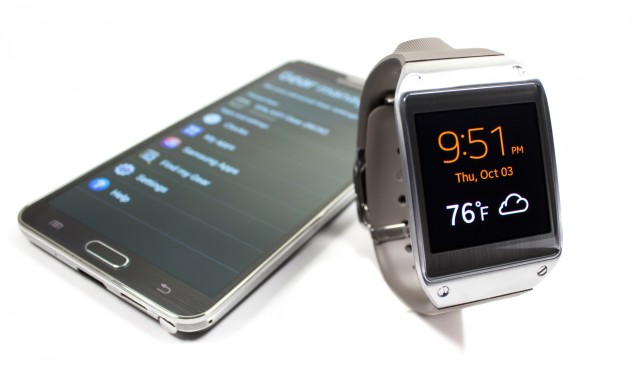
When a new article is posted on the Internet, the first addition to the comments section is often an inconsequential, one-word statement: "First!"
The frequent "First!" cry of the Internet troll declares some strange pride in being the first to comment on an article. The commenter put little to no effort into the post; it added nothing to the conversation, and it was completely devoid of substance. The troll did secure the spot at the top of the thread, though, and every additional commenter will be forced to scroll past the pointless contribution.
The Samsung Galaxy Gear says "First!" in hardware form. Samsung has beaten Google and Apple as the first major manufacturer to market, but much like the Internet commenter, it has sacrificed substance for the sake of timing. The Galaxy Gear is a product (with some impressive internals, no less) that has such limited use and such crippling compatibility requirements that it is currently the equivalent of hardware spam. While the Gear won't even come close to serving the needs of the vast majority of people, we're going to be talking about smartwatches a lot in the coming months, so if nothing else, the Gear provides a great starting point.
The hardware
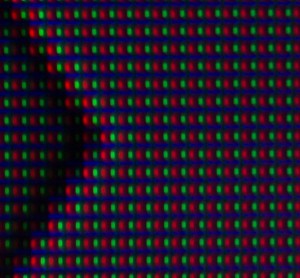
Before we get into the list of deal-breakers, though, let's talk about the actual device. The face of the Gear features a 1.63-inch, 320×320 AMOLED touchscreen. A macro shot reveals the screen to have an S-stripe subpixel layout, the same display tech used in the Note 2. The Gear's display is passable, but the 277PPI means this is not the super-dense pixel party to which we've grown accustomed. Samsung's software doesn't push the display very hard, though, so it's not a big deal.
The exterior of the case is pretty sparse, with only a power button and a few pinhole mics on either side. In this tiny space, Samsung manages to pack a 800MHz Exynos 4212 processor, 512MB of memory, 4GB of storage, and a whopping 315 mAh battery. CPU-Z recognizes the Exynos as a dual-core chip, but the second core seems to be permanently disabled.
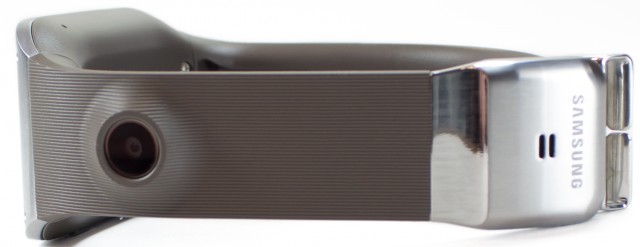
The most unique aspect of the Galaxy Gear is that there are electronics built into the entire watch. Unlike the Pebble (or a sixth-gen iPod Nano equipped with a watchband), which has a "dumb" band and contains all the electronics in the body of the watch, the Gear integrates a 1.9MP camera into the watchband and a speaker into the clasp. The side effect of this is that the band is a permanent part of the watch—you won't be seeing swappable bands any time soon.
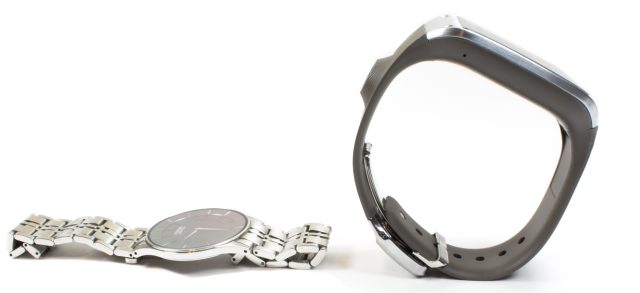
At about 11 mm (0.43") in depth, the case of the Gear is the normal thickness of a wrist watch. There's nothing about the depth that should make it look bad or geeky—men's jewelry watches are usually in the 5-14 mm range. Despite being in the size range of a normal watch, the Gear still looks unusual on the wrist thanks to the rubbery watchband. A normal chain link watchband is full of hinges, so it can never "support" the watch. With no support, the watch collapses onto the wrist, and any slack in the band will hang down by the clasp. The Gear's rubber band, however, is so stiff and supportive that any slack will cause the watch to "float" around your wrist and appear much thicker than it is. It's more like wearing a rigid bracelet than a real watch. The picture above tells the tale. On a table, a normal watch collapses into a heap, but the Gear is so stiff that it's self-supportive.
It seems that the primary reason for the rigid band is to give the camera a home and a sturdy connection to the rest of the phone. Considering the Gear requires a smartphone to be useful, the only reason for it to have a camera is convenience—you're guaranteed to have a much better one in your pocket. Without the camera, Samsung would only need to stash the speaker somewhere, and the band could be removable—or made out of something classier, like metal or leather. That would have helped its appearance dramatically.
-
The Gear with the charger case attached.
-
The front of the charger case, with pogo pins.
-
The open charger case, and the back of the Gear. The gold pogo contacts transfer power from the plugged-in charger to the Gear.
-
The back of the charger case, with micro-USB port.
-
The clasp.
One neat solution Samsung has come up with: the Gear has no on-board micro-USB port. Rather than make the watch thicker, the Gear's micro-USB port is offloaded to a separate "charging case." A plastic shell clips around the watch and connects to the internals via pogo pins on the bottom of the watch case. The shell has a door that surrounds the screen and locks into place for a secure connection. There is even an NFC chip in the charger to easily pair the Gear to your Samsung phone.
Samsung's designers adorned the front of the case with faux leather plastic and stitching. Unlike the Note 3, though, this isn't soft touch plastic, just hard, regular plastic, so it's more like faux faux-leather.
The software
The Galaxy Gear runs a heavily customized version of Android 4.2.2 (some parts are still referred to as "Touchwiz"). Navigation is fast and easy: Android's Back button is handled by swiping down from the top of the screen, tapping the power button works as Home, and there is the occasional on-screen menu button in the top right of the screen.

The software functions similarly to Google Glass. Everything is in a simple, horizontal UI. The "home screen" is a configurable watch face that can show the time, date, weather, and/or app shortcuts. Swiping left and right will take you through your primary apps, one at a time; tapping on an icon will open the app. Pretty simple stuff. The watch connects to your Samsung phone via Bluetooth and has a companion app that you can use to configure settings, install apps, and even make the Gear ring for easy locating if you lose it.
The Gear will turn on when you lift your arm up to check the time. Indeed, it can pretty reliably detect when you're looking at it thanks to the accelerometers. The detection feels pretty slow, though. You're staring at a blank screen for about a second before it kicks on. It's definitely not "glanceable," and the short delay is irritating.

The software itself is unattractive. It's a bleak mix of black, white, and orange coupled with primitive artwork. It reminds me of Android circa Gingerbread or Froyo, when the UI looked like something some programmer threw together in his spare time. The black background is probably to conserve power on the AMOLED display, but if you've ever used a 6th gen iPod nano, you know small devices don't have to be like this. So many screens are so completely devoid of color, you'd be forgiven for thinking the display was only capable of three colors.
The above middle screenshot is of one of the cooler features—the media controls. This app will act as a remote Bluetooth controller for whatever music app you currently have open on the paired device. It will display the track name while playing and allow you to adjust the phone's volume.

There's no keyboard, so other than the touchscreen, your only other form of input comes via a stripped-down version of S-Voice. You can dictate text messages (but not e-mails), make phone calls, launch apps, add calendar events, and bring up the weather, all with your voice. There's no answer service, though (for instance "how old is Barack Obama?"), and despite the integrated speaker, S-Voice never speaks. It just quietly displays what you asked for.
S-Voice is extremely slow—you can really feel the 800MHz processor chug. It usually takes a few seconds to open and a few more to respond to a spoken command. Performance across the board is not very good. Indeed, the UI drops animation frames all over the place. After using the device, I felt like I was back in the stuttery Android dark ages.

Phone calls are the best piece of functionality on the Gear. The device is basically a wrist-mounted speaker phone. You can dial with S-Voice or with a microscopic dial pad. You can answer incoming calls, hang up, mute, or pass the call to your Bluetooth headset or smartphone. The quality on either end isn't spectacular, but it's a watch—what were you expecting?
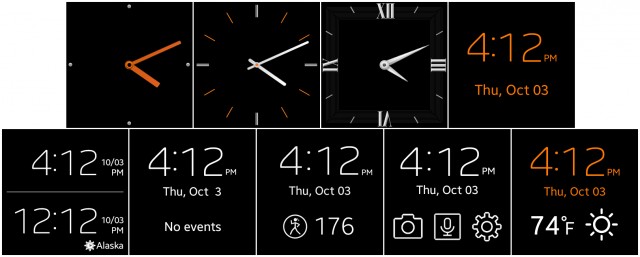
There are a variety of watch faces to choose from. If you go the digital route, you can display the date, a second clock, a pedometer, app shortcuts, or the weather beneath the time.
reader comments
212